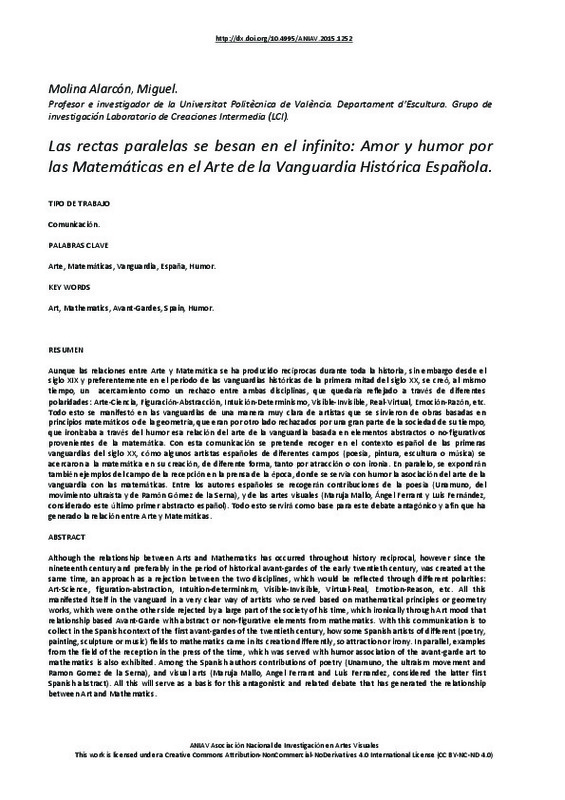|
Resumen:
|
[EN] Although the relationship between Arts and Mathematics has occurred throughout history reciprocal, however since the nineteenth century and preferably in the period of historical avantgardes of the early twentieth ...[+]
[EN] Although the relationship between Arts and Mathematics has occurred throughout history reciprocal, however since the nineteenth century and preferably in the period of historical avantgardes of the early twentieth century, was created at the same time, an approach as a rejection between the two disciplines, which would be reflected through different polarities: Art Science, figuration-abstraction, Intuition-determinism, Visible-Invisible, Virtual-Real, Emotion-Reason, etc. All this manifested itself in the vanguard in a very clear way of artists who served based on mathematical principles or geometry works, which were on the other side rejected by a large part of the society of his time, which ironically through Art mood that relationship based AvantGGarde with abstract or non-figurative elements from mathematics. With this communication is to collect in the Spanish context of the first avantgardes of the twentieth century, how some Spanish artists of different (poetry, painting, sculpture or music) fields to mathematics came in its creation differently, so attraction or irony. In parallel, examples from the field of the reception in the press of the time, which was served with humor association of the avantgarde art to mathematics is also exhibited. Among the Spanish authors contributions of poetry (Unamuno, the ultraism movement and Ramon Gomez de la Serna), and visual arts (Maruja Mallo, Angel Ferrant and Luis Fernandez, considered the latter first Spanish abstract). All this will serve as a basis for this antagonistic and related debate that has generated the relationship between Art and Mathematics.
[-]
[ES] Aunque las relaciones entre Arte y Matemática se ha producido recíproca durante toda la historia, sin embargo desde el siglo XIX y preferentemente en el periodo de las vanguardias históricas de la primera mitad del ...[+]
[ES] Aunque las relaciones entre Arte y Matemática se ha producido recíproca durante toda la historia, sin embargo desde el siglo XIX y preferentemente en el periodo de las vanguardias históricas de la primera mitad del siglo XX, se creó, al mismo tiempo, un acercamiento como un rechazo entre ambas disciplinas, que quedaría reflejado a través de diferentes polaridades: Arte-Ciencia, Figuración-Abstracción, Intuición-Determinismo, Visible-Invisible, Real-Virtual, Emoción-Razón, etc. Todo esto se manifestó en las vanguardias de una manera muy clara de artistas que se sirvieron de obras basadas en principios matemáticos o de la geometría, que eran por otro lado rechazados por una gran parte de la sociedad de su tiempo, que ironizaba a través del humor esa relación del arte de la vanguardia basada con elementos abstractos o no-figurativos provenientes de la matemática. Con esta comunicación se pretende recoger en el contexto español de las primeras vanguardias del siglo XX, cómo algunos artistas españoles de diferentes campos (poesía, pintura, escultura o música) se acercaron a la matemática en su creación, de diferente forma, tanto por atracción o con ironía. En paralelo, se expondrán también ejemplos del campo de la recepción en la prensa de la época, donde se servía con humor la asociación del arte de la vanguardia con las matemáticas. Entre los autores españoles se recogerán contribuciones de la poesía (Unamuno, del movimiento ultraísta y de Ramón Gómez de la Serna), la música (Rodolfo Halffter) y de las artes visuales (Maruja Mallo, Ángel Ferrant y Luis Fernández, considerado este último primer abstracto español). Todo esto servirá como base para este debate antagónico y afín que ha generado la relación entre Arte y Matemáticas
[-]
|









